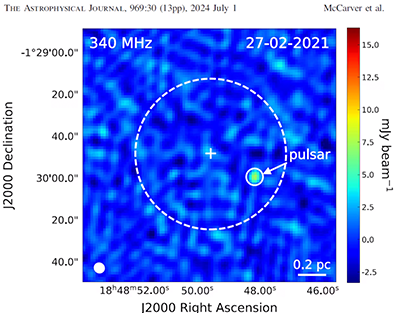



Even in her single-digit youth, Amaris McCarver knew she wanted to be a scientist.
“I just wanted to understand something about the way that the universe works,” she says. “I wanted to discover something.”
McCarver was especially drawn to the unexplained, watching YouTube videos on black holes and neutron stars for hours.
“I was interested by the fact that there were so many mysteries.”
Fast forward to now, the senior at Texas Tech University has explored the stars, discovered new celestial bodies, earned prestigious awards, and achieved a first author credit on a well-received science journal article. She has become one of the solvers of the mysteries she has found so intriguing, helping science to explain the universe.
McCarver attributes some of that success to the opportunities she found during her Naval Research Enterprise Internship Program (NREIP) experience at the Naval Research Lab (NRL), during which she performed the advanced research made the discovery that garnered that journal byline.
“I feel like it's honestly hard to put into words how valuable that internship has been,” she says.
Talking about her research, McCarver sounds like a PhD candidate, comfortably discussing her work in advanced scientific terms. (“Pulsars are like rotating neutron stars that admit beams of electromagnetic radiation from their poles.”)
For her internship, McCarver studied images produced by NRL’s VLA Low-band Ionosphere and Transient Experiment (VLITE) to search for pulsars among nearly 100 globular clusters – large, dense groupings of stars held together by gravitational forces. One of those clusters – GLIMPSE-C01 – had already been searched in the past but that investigation produced no clear evidence of a pulsar.
However, McCarver found one.
The discovery’s significance has profound implications for our understanding of the universe as well practical applications.
“They provide us a way to probe physics in a way that we can't replicate on earth,” McCarver explains. “Discovering new pulsars has benefits to projects that use both our timing arrays and study of the propagation of gravitational waves in the universe.”
They can also be used future astronauts navigate space – think of these spinning objects emitting pulsations at specific frequencies as interstellar lighthouses, giving spacecraft the ability to determine their position and, given their consistency, the time.
After McCarver’s first NREIP summer following her freshman year, she went on to spend the next two summers with NRL, as well, and even did a “Winternship.” She gave presentations such as the one titled “A Search for Pulsars in Globular Clusters,” at Texas Tech’s Department of Physics and Astronomy’s Astronight. The Texas Section of the American Physical Society presented her with the Robert S. Hyer Research Award which recognizes research excellence by an undergraduate student. And she co-authored “A VLITE Search for Millisecond Pulsars in Globular Clusters: Discovery of a Pulsar in GLIMPSE-C01” with her professor and advisor Thomas Maccarone, who initially recommended NREIP to her.
Her family is immensely proud, of course.
“Every time I discover something or something gets published about the pulsar and Glimpse-CO1, I send it to them and they're always really happy to see it, even if they're not familiar with astronomy,” she says.
McCarver’s plans to continue onto a PhD program and to stay in academia, though her time at NRL “opened my eyes to a whole other possible avenue that I could go through and still do research and astronomy that I enjoy, that's outside of academia.”
Whichever direction she decides on, however, it’s obvious her thoughts will always remain among the stars.
“I’ve really enjoyed every step of the journey,” she says. “It honestly doesn’t feel like work and the fact that I found something and it's gaining attention, and it seems like it's an important discovery, it just shows me that I'm on the right path.”